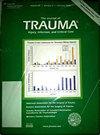Frontal placement of subdural drain for subdural hemorrhage: A single center experience
Journal of Trauma-Injury Infection and Critical Care
Pub Date : 2019-01-01
DOI:10.35841/2591-7358.3.1.12-14
引用次数: 0
Abstract
Placing a drain following evacuation of Chronic Subdural Hemorrhage (CSDH) has beneficial outcome for patients. The placement of the drain’s tip however is debatable as it has different rationale among neurosurgeons. Objective: The objective is to see whether the outcome is satisfactory by putting the tip of the drain at the frontal region of the sub dural space. Methodology: We retrospectively studied all patients who had CSDH underwent surgery in our center between January 2013 to December 2016. A total of 34 patients with CSDH underwent drilling of one burr hole and irrigation of CSDH. Silicone catheter placed in the sub dural space and the tip of the drain in the frontal region. We measured the SDH volume reduction and volume of pneumocranium post operatively as our outcomes of the study. Results: The mean reduction of SDH volume after surgery is 8.11 cc (73%), while the mean volume of pneumocranium post SDH drainage is 1.58 cc with a range of 0 cc to 9 cc. The mean Global Outcome Score is 2.85 and the recurrence, which need re-operation are 2 cases (6%). Conclusion: The retrospective case series shows a good potential outcome based on the reduction of SDH volume after surgery. A proper randomized trial is needed to determine the efficacy of the frontal placement of the subdural catheter for a comparable outcome.硬脑膜下引流术治疗硬脑膜下出血:单中心经验
慢性硬膜下出血(CSDH)术后引流对患者有益。然而,引流管尖端的位置是有争议的,因为神经外科医生有不同的理由。目的:目的是通过将引流管尖端置于硬脑膜下间隙额部,观察其效果是否满意。方法:我们回顾性研究了2013年1月至2016年12月在我中心接受手术的所有CSDH患者。34例CSDH患者行1个毛刺钻孔和CSDH冲洗。硅胶导管放置在硬脑膜下间隙和额部引流管尖端。我们测量了SDH体积减少和术后肺颅骨体积作为我们研究的结果。结果:术后SDH体积平均减少8.11 cc (73%), SDH引流后肺容积平均减少1.58 cc (0 ~ 9 cc), Global Outcome Score平均2.85,复发需再手术2例(6%)。结论:回顾性病例系列显示手术后SDH体积减少的良好潜在结果。需要一项适当的随机试验来确定硬膜下导管正面放置的有效性,以获得可比的结果。
本文章由计算机程序翻译,如有差异,请以英文原文为准。
求助全文
约1分钟内获得全文
求助全文
来源期刊

Journal of Trauma-Injury Infection and Critical Care
CRITICAL CARE MEDICINE-EMERGENCY MEDICINE
自引率
0.00%
发文量
0
审稿时长
3 months
 求助内容:
求助内容: 应助结果提醒方式:
应助结果提醒方式:


